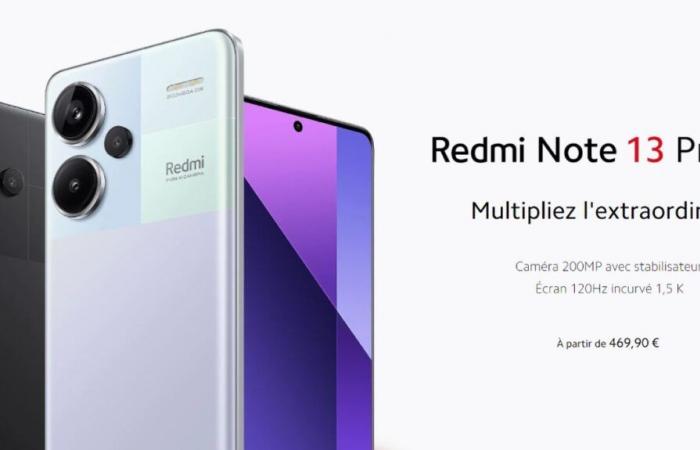
The three models in the Redmi Note range adopt a modern and refined design, with subtle differences that can guide your choice. The Redmi Note 13 Pro+ 5G is distinguished by its slightly rounded edges on the back and its photo sensors located in the upper left corner. These sensors protrude slightly from the hull, without superfluous ornament, on a smooth surface. It is available in three colors: black, purple and white, and benefits from IP68 certification, making it waterproof and dust-resistant.
The Redmi Note 13 Pro 5G, meanwhile, sports flat profiles and integrated photo sensors on a plate matching the color of the device. Available in black, purple and blue, it is also IP54 certified, offering increased resistance to splashes and dust, without reaching the waterproof level of the Pro+.
Finally, the Redmi Note 13 5G opts for a sober style with sensors positioned in the upper left corner, leaving only the lenses protruding. This model features the thinnest profiles in the range with a thickness of just 7.6mm and weighs 174.5g, making it the lightest of the three. It is available in black, blue and white and also offers IP54 certification.
In terms of size, the Redmi Note 13 Pro+ 5G is the heaviest (204.5 g), followed by the Redmi Note 13 Pro 5G (187 g). All three offer a 6.67-inch screen, but the Pro+ is slightly thicker, at 8.9mm. These design differences are reflected in the ease of use and overall robustness of each device.
Which is the most powerful and which is the best screen?
The Redmi Note 13 Pro+ 5G is equipped with the MediaTek Dimensity 7200-Ultra processor, coupled with 8 or 12 GB of RAM and up to 512 GB of internal storage. It does not allow storage expansion via a micro SD card, but its power makes it an ideal choice for demanding users. The Redmi Note 13 Pro 5G, for its part, features a Qualcomm Snapdragon 7s Gen 2, with similar RAM and storage configurations. This model, like the Pro+, is not expandable by micro SD, but it stands out for optimized energy management thanks to its Snapdragon processor.
Finally, the Redmi Note 13 5G is based on a MediaTek Dimensity 6080, with 8 GB of RAM and 256 GB of internal storage. Unlike the other two models, it offers the possibility of expanding its memory using a micro SD card, an asset for users needing flexibility.
In terms of raw power, the ranking is as follows: the Pro+ dominates, followed by the Pro and finally the Redmi Note 13 5G, which remains a solid option for everyday use.
All three models feature 6.67-inch AMOLED screens with a 120Hz refresh rate, providing optimal fluidity. However, notable differences remain: the Redmi Note 13 Pro+ 5G and Pro 5G display a higher definition of 1220×2712 pixels and support HDR10+ and Dolby Vision technologies, with an impressive maximum brightness of 1800 cd/m². These screens are protected by Corning Gorilla Glass Victus, a guarantee of robustness.
The Redmi Note 13 5G, although it shares the same refresh rate and maximum brightness, is limited to a definition of 1080×2400 pixels and HDR10. It is protected by Corning Gorilla Glass 5, which is slightly less resistant.
In terms of display quality, the Pro+ takes the lead thanks to its definition and Dolby Vision support, followed by the Pro. The Redmi Note 13 5G, although efficient, is positioned behind.
What configurations for photos and what connectivity?
In photography, the Redmi Note 13 Pro+ 5G and Pro 5G stand out thanks to a 200-megapixel main sensor with optical stabilization, accompanied by an 8-megapixel ultra-wide-angle and a 2-megapixel macro sensor. These two models also include a 16-megapixel selfie sensor. The Redmi Note 13 5G, on the other hand, offers a 108-megapixel main sensor, an 8-megapixel ultra-wide-angle and a 2-megapixel macro, with a 16-megapixel selfie sensor identical to the other two.
The Pro+ stands out for the rich detail it captures, closely followed by the Pro. The Redmi Note 13 5G remains a decent option, but less versatile in low light conditions.
In terms of connectivity, all three models are compatible with 5G and integrate NFC technology, Bluetooth (version 5.3 for the Pro+ and the Redmi Note 13, 5.2 for the Pro), and an infrared transmitter. The Redmi Note 13 Pro+ and the Pro integrate a fingerprint reader under the screen, while that of the Redmi Note 13 is placed on the more traditional sleep button.
What about autonomy and charging capabilities?
The Redmi Note 13 Pro+ 5G and Pro 5G share similar batteries, with 5000 mAh and 5100 mAh respectively. The Redmi Note 13 5G also has a 5000 mAh battery, but the difference is in the charging speed. The Pro+ supports fast charging at 120 watts, allowing a full charge in around 20 minutes, followed by the Pro with 67 watts, then the Redmi Note 13 with 33 watts.
None of the three models offer wireless charging. However, the Pro+ once again stands out thanks to its blazing charging speed, ideal for users in a hurry.





